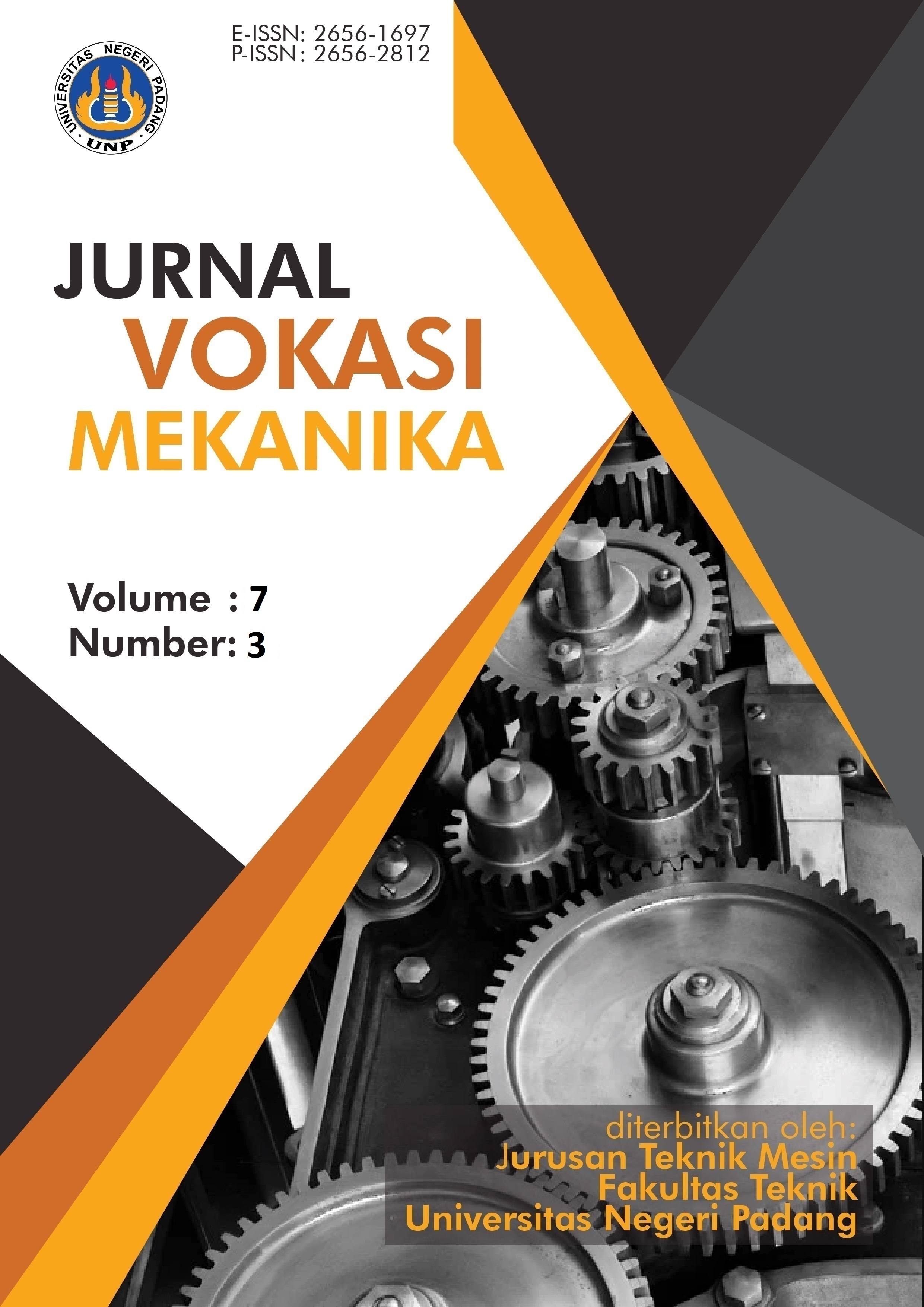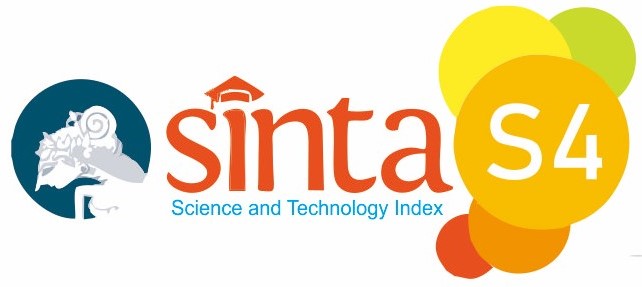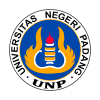Utilizing Augmented Reality Media to Enhance Students’ Lathe Learning Outcomes
Abstract
The integration of technology in vocational education has become a critical need to support 21st-century skills, especially in practice-based learning such as Basic Mechanical Engineering subjects. One promising innovation is the use of Augmented Reality (AR) media, which enables interactive three-dimensional visualization to help students concretely understand abstract concepts. This study aims to examine the effectiveness of lathe-based AR media in improving student learning outcomes and motivation in Grade X of the Machining Engineering Department at SMK Semen Padang. The research employed a quasi-experimental method using a non-equivalent control group design. The subjects consisted of two classes: the experimental class (using AR media) and the control class (using conventional learning methods). Data were collected using pre-tests and post-tests to assess learning outcomes and Likert-scale questionnaires to evaluate learning motivation. The analysis results showed that the use of AR media significantly increased student learning outcomes and motivation compared to traditional methods. Based on hypothesis testing and normalized gain score analysis, the AR media was found to be highly effective in the learning process. In conclusion, lathe-based Augmented Reality media proved to be an effective interactive learning tool that enhances students' academic performance and motivation, while also contributing to the development of innovative media in technical education.
References
Afjar, A. M., Musri, & Syukri, M. (2020). Attention, relevance, confidence, satisfaction (ARCS) model on students’ motivation and learning outcomes in learning physics. Journal of Physics: Conference Series, 1460(1). https://doi.org/10.1088/1742-6596/1460/1/012119
Akpan, B., Ebenezer, E., & Lion, C. J. (2023). Independent T-Test Statistics: It’S Relevance in Educational Research. International Journal of Eminent Scholars, 10(1), 2659–1057. https://www.globalacademicstar.com/download/article/independent-t-test-statistics-it-s-relevance-in-educational-research.pdf
Biocca, F., Owen, C., Tang, A., & Bohil, C. (2007). Attention issues in spatial information systems: Directing mobile users’ visual attention using augmented reality. Journal of Management Information Systems, 23(4), 163–184. https://doi.org/10.2753/MIS0742-1222230408
Cieza, E., & Lujan, D. (2018). Educational Mobile Application of Augmented Reality Based on Markers to Improve the Learning of Vowel Usage and Numbers for Children of a Kindergarten in Trujillo. Procedia Computer Science, 130, 352–358. https://doi.org/10.1016/j.procs.2018.04.051
Dewi, A. C., Yahya, M., & Darmawang. (2022). Efektifitas model pembelajaran perbasis proyek pada mata kuliah perencanaan pembelajaran kejuruan. Jurnal Konsepsi, 11(2), 373–379. https://p3i.my.id/index.php/konsepsi/article/view/226
GÜLER, O., & YÜCEDAĞ, İ. (2018). Developing an CNC lathe augmented reality application for industrial maintanance training. 2018 2nd International Symposium on Multidisciplinary Studies and Innovative Technologies (ISMSIT), 2–7.
Kaur, D. P., Mantri, A., & Horan, B. (2020). Enhancing student motivation with use of augmented reality for interactive learning in engineering education. Procedia Computer Science, 172(2019), 881–885. https://doi.org/10.1016/j.procs.2020.05.127
Kongkaew, C., Scholfield, C. N., Supapaan, T., Mann, C., Mongkhon, P., & Chanunun, S. (2019). Impact of research-based learning on student knowledge and assessment in pharmacoepidemiology: A one-group pretest-posttest experimental study. Thai Journal of Pharmaceutical Sciences, 43(4), 236–241. https://doi.org/10.56808/3027-7922.3059
Miller, C. J., Smith, S. N., & Pugatch, M. (2020). Experimental and quasi-experimental designs in implementation research. Psychiatry Research, 283(March 2019), 112452. https://doi.org/10.1016/j.psychres.2019.06.027
Mukhayyaroh, I. A., & Arief, S. (2018). Penerapan project based learning untuk meningkatkan kreativitas, motivasi belajar dan hasil belajar. Economic Education Analysis Journal, 7(1), 1–14.
Muklis, M., Prasetya, F., Ambiyar, A., & Sari, D. Y. (2022). Pengembangan Media Pembelajaran Augmented Reality Berbasis Android Pada Mata Kuliah Teknologi Pemesinan. Jurnal Vokasi Mekanika (VoMek), 4(3), 37–42. https://doi.org/10.24036/vomek.v4i3.412
Putra, A. B. N. R., Mukhadis, A., Ulfatin, N., Tuwoso, Subandi, M. S., Hardika, & Muhammad, A. K. (2021). The Innovation of Disruptive Learning Media with Augmented Reality Based 3D Object Concept with Drill Machine Design to Improve Quality of Distance Learning in The Era of Education 4.0. International Journal of Interactive Mobile Technologies, 15(12), 193–200. https://doi.org/10.3991/ijim.v15i12.21579
Rahmatullah, A. S., Mulyasa, E., Syahrani, S., Pongpalilu, F., & Putri, R. E. (2022). Digital Era 4.0: The Contribution to Education and Student Psychology. Linguistics and Culture Review, 6, 89–107. https://doi.org/10.21744/lingcure.v6ns3.2064
Sahanata, M., & Kumala Dewi, F. (2022). The Effect of Application of the ARCS Learning Model on Motivation Learn Maths Students. Journal of Curriculum and Pedagogic Studies (JCPS), 1(1), 1–11. https://e-journal.lp2m.uinjambi.ac.id/ojp/index.php/jcps
Salmah, S., Souad, D. M., & Daraiffah. (2020). Dampak Pengelompokkan Siswa Berdasarkan Kemampuan Dan Status Sosial Ekonomi Terhadap Prestasi Akademik Siswa: Persepsi Guru Dan Orang Tua. Edu Research, 1(3), 30–42. https://doi.org/10.47827/vol1iss3pp30-42
Sulaeman, Z. M., Nurlaeli, A., & Ma’shum, S. (2024). Implemetasi Kurikulum Pusat Keunggulan Melalui Program Magang Industri di SMK 1 Cikarang Selatan. Indonesian Research Journal on Education, 4(2), 29–35. https://doi.org/10.31004/irje.v4i2.476
Suryanto, A., Kusumawati, D. A., & Sanhoury, I. M. H. (2018). Development of Augmented Reality Technology Based Learning Media of Lathe Machines. Jurnal Pendidikan Teknologi Dan Kejuruan, 24(1), 32–38. https://doi.org/10.21831/jptk.v24i1.18245
Suwondo, S., Refdinal, R., Ambiyar, A., & Aswardi, A. (2024). Development of E-Learning Module for Lathe Machining Techniques with a Service-Learning Approach in Vocational High Schools. AL-ISHLAH: Jurnal Pendidikan, 16(4), 5887–5896. https://doi.org/10.35445/alishlah.v16i4.6250
Takrouri, K., Causton, E., & Simpson, B. (2022). AR Technologies in Engineering Education: Applications, Potential, and Limitations. Digital, 2(2), 171–190. https://doi.org/10.3390/digital2020011
Zhou, Y., Zhu, Y., & Wong, W. K. (2023). Statistical tests for homogeneity of variance for clinical trials and recommendations. Contemporary Clinical Trials Communications, 33(March), 101119. https://doi.org/10.1016/j.conctc.2023.101119
Submitted
Copyright (c) 2025 Jurnal Vokasi Mekanika (VoMek)

This work is licensed under a Creative Commons Attribution 4.0 International License.








.svg_.png)


